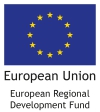In this mini-series, we introduce our national Contact Points from around the programme area. The national Contact Points are the link between the programme and the regions. They inform about the funding opportunities and provide first information to potential applicants. Contact Points also help with partner search and matchmaking. In addition, they follow projects closely to share/spread project results and communicate the benefits of cross-border cooperation.
Part 1: Our national Contact Point on Åland - Ester Laurell
Part 2: Our national Contact Point in Finland - Jaakko Ranta
Part 3: Our national Contact Point in Latvia - Ilze Legzdina
Annika Holmström
(2018)
In Sweden we are two Contact Points available to inform about the Interreg Central Baltic Programme – one in Stockholm and one in Linköping.
I am one of them, and I started in August 2017. I am currently located in Linköping, which is in the south part of the geographical area formed by the eight Swedish regions involved in the Central Baltic Programme.
How did you end up working with Central Baltic?
The last 15 years I have worked with international contacts at the County Administrative Board of Östergötland, Sweden. Apart from being International Coordinator, I have also been the Project Manager for a large Central Balic Programme project during the earlier programme period. Those experiences have been very positive, especially as regards to the rewarding effects of cross-border cooperation.
Since long I have been very much pro-EU and I think that it is great to develop things together instead of being locked up behind borders. That is the best way to develop innovative and peaceful regions within the EU. You get the opportunity to exchange experiences, and become inspired by the people you collaborate with.
I am very pleased to be able to support the Central Baltic project applicants and to spread information about the projects’ results.
What does a typical working day look like?
A typical working day starts at 8.30 with meetings in the morning and going through e-mails, booking travels or other administrative tasks. Usually I am in touch with with my colleague in Stockholm, in order to coordinate our plans and decide who will do what. After that I continue with what is on hand during the rest of the day – for example writing articles about our projects.
What are you currently working with?
At the moment I am finalizing articles from the interviews I have done with “my” Central Baltic projects. The articles are to be published on the Central Baltic webpage, and the idea is to allow the projects to come alive and become more concrete, in comparison to the overall project information that is to be found elsewhere in our webpage. There are so many interesting things happening in our projects and we would like to follow their implementation and visualize their results.
Out of 97 approved projects Sweden is taking part in 51, and it is important to try to keep up with what happens in the projects.
What is the best thing about your work?
The best thing is to be in touch with all the energetic people behind the projects. And to give support, energy and encouragement back!
Part 1: Our national Contact Point on Åland - Ester Laurell
Part 2: Our national Contact Point in Finland - Jaakko Ranta
Part 3: Our national Contact Point in Latvia - Ilze Legzdina
Annika Holmström
(2018)

In Sweden we are two Contact Points available to inform about the Interreg Central Baltic Programme – one in Stockholm and one in Linköping.
I am one of them, and I started in August 2017. I am currently located in Linköping, which is in the south part of the geographical area formed by the eight Swedish regions involved in the Central Baltic Programme.
How did you end up working with Central Baltic?
The last 15 years I have worked with international contacts at the County Administrative Board of Östergötland, Sweden. Apart from being International Coordinator, I have also been the Project Manager for a large Central Balic Programme project during the earlier programme period. Those experiences have been very positive, especially as regards to the rewarding effects of cross-border cooperation.
Since long I have been very much pro-EU and I think that it is great to develop things together instead of being locked up behind borders. That is the best way to develop innovative and peaceful regions within the EU. You get the opportunity to exchange experiences, and become inspired by the people you collaborate with.
I am very pleased to be able to support the Central Baltic project applicants and to spread information about the projects’ results.
What does a typical working day look like?
A typical working day starts at 8.30 with meetings in the morning and going through e-mails, booking travels or other administrative tasks. Usually I am in touch with with my colleague in Stockholm, in order to coordinate our plans and decide who will do what. After that I continue with what is on hand during the rest of the day – for example writing articles about our projects.
What are you currently working with?
At the moment I am finalizing articles from the interviews I have done with “my” Central Baltic projects. The articles are to be published on the Central Baltic webpage, and the idea is to allow the projects to come alive and become more concrete, in comparison to the overall project information that is to be found elsewhere in our webpage. There are so many interesting things happening in our projects and we would like to follow their implementation and visualize their results.
Out of 97 approved projects Sweden is taking part in 51, and it is important to try to keep up with what happens in the projects.
What is the best thing about your work?
The best thing is to be in touch with all the energetic people behind the projects. And to give support, energy and encouragement back!


